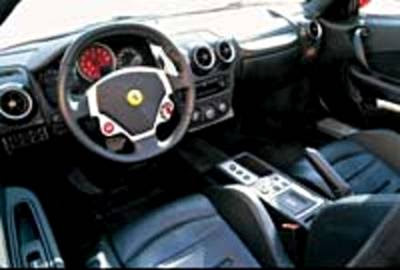World premiere of the new Ferrari F430 Spider took place in Geneva in the summer 2005. The new generation of 8-cylinder Ferrari's F430 is enriched Spider.
 Among the important innovations on this new Ferrari 'open', are the electronic differential control, developed by Ferrari for F1 race car, able to fully exploit the torque of the engine to maximize the values of traction and control on the steering wheel, called "manettino" from the pilots Squadra, which allows you to act quickly on the various systems that govern the dynamics of the vehicle, occur without any lowering of the level of attention by the driver.
Among the important innovations on this new Ferrari 'open', are the electronic differential control, developed by Ferrari for F1 race car, able to fully exploit the torque of the engine to maximize the values of traction and control on the steering wheel, called "manettino" from the pilots Squadra, which allows you to act quickly on the various systems that govern the dynamics of the vehicle, occur without any lowering of the level of attention by the driver. Formula 1 and it is confirmed to be the lab's advanced research also open to cars, the Ferrari F430 Spider, designed by Pininfarina, uses the latest aerodynamic calculation methodology developed in collaboration with Manage S. House of Maranello.
Formula 1 and it is confirmed to be the lab's advanced research also open to cars, the Ferrari F430 Spider, designed by Pininfarina, uses the latest aerodynamic calculation methodology developed in collaboration with Manage S. House of Maranello. The new design concrete sought the aerodynamic work and integrated into the bonnet, the new design more muscular engine of air taken from extractor and less generous size, derived from competitions. The large glass rear allows viewing of the propeller.
The new design concrete sought the aerodynamic work and integrated into the bonnet, the new design more muscular engine of air taken from extractor and less generous size, derived from competitions. The large glass rear allows viewing of the propeller. ferrari car galleryThe Ferrari F430 Spider in the electrical system of opening and closing of the roof is fully automatic, and the folding of the hood, a complete disappearance, is in extremely small spaces, such as to preserve the uniqueness of the engine on sight, while a spider into the rear engine -Central.
ferrari car galleryThe Ferrari F430 Spider in the electrical system of opening and closing of the roof is fully automatic, and the folding of the hood, a complete disappearance, is in extremely small spaces, such as to preserve the uniqueness of the engine on sight, while a spider into the rear engine -Central.
The new front is characterized by two air inlets of elliptical shape that fuel large radiators called to dispose of the high power of the engine. The shape is inspired by the competition of vintage Ferrari 1961, world champions in F1 with Phil Hill. At the bottom of the air inlets are united by a wing that directs the flow toward the bottom plate.
The engine is the new 90 ° V8 with a displacement of 4308 cm3 and 490 hp, compact and lightweight, able to achieve a specific power of 114 hp per liter and give the new Ferrari spider a weight / power 2.9 Kg / Hp dry. The benefits are of absolute excellence: acceleration from zero to 100 km / h in 4.1 seconds and top speed exceeding 310 km / h.



No comments:
Post a Comment